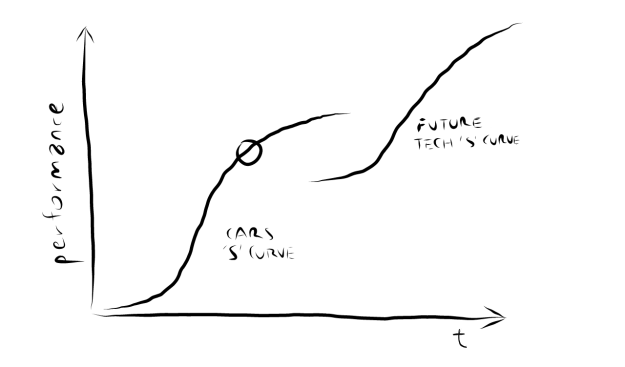I have recently read a few articles on self driving cars. The Mechanical Engineer in me is thrilled by the idea of such technologically advanced artifacts able to actually understand the external environment and take even better decisions than any driver.
Proponents of this new technology argue that it would definitely contribute to the economy by increasing the efficiency of people, that is, you will be able to send emails and make phone calls while struck in traffic.
I would contend that, practical issues aside such as possible motion sickness of passengers or availability of connectivity,the introduction of the new generation of cars, would be only an incremental improvement similar to the ones represented by ABS or GPS navigation systems. Both were able to improve the overall concept of “car” and save thousands of lives. However, in those cases, like in this one, the car remained still a car.
To say it with the language introduced by Foster (1986), we’re moving on the same S-Curve. The picture below, suggest that, no matter how much technology we are able to pack in a car, the performances of this 100 years old technology will be marginally decreasing and we will still be plagued with the same issues of being struck in traffic and burning CO2-generating fossil fuels.

The promise of being able to work during commuting time does not improve the perspective for self-driving cars, if we assume it is possible to work remotely why commuting in first instance? If it is really the case we could setup our own home office like this one.
Given the next generation of cars will be better than humans at driving, they would reduce the number of incidents and speed tickets, both great news but not solving the central issue of mass transportation.
On other side of the spectrum, there some pioneers experimenting new solutions such as SkyTran, a Personal Rapid Transit system designed from the beginning, to solve the problems of public transportation (video).
Between engineering phases, homologation and testing, the Skytran system might be decades away from public deployment, however, it represent one innovative way of looking at a problem and an admirable entrepreneurial effort.
For more on the technology and innovation from the academic perspective see:
Geroski. P.A. 2003. The Evolution of New Markets (TENM). Oxford University Press.
Foster R, 2006, “Innovation: the attacker’s advantage”, Macmillian London, 320p, ISBN 9780333435113